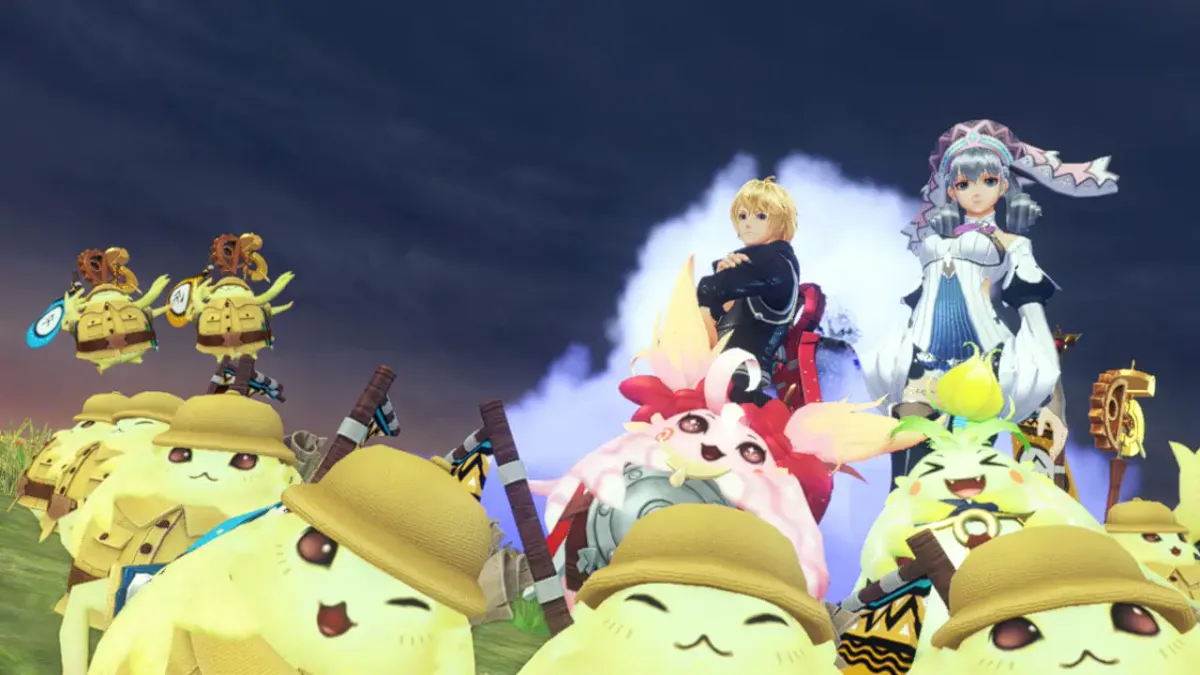
Long ago, two titans were locked in an endless battle. One organic, the Bionis, and the other mechanical, the Mechonis, the two struggled until only their corpses remained. Now, eons later, their fight is continued by their children. The Mechon mindlessly seek the extermination of all life on Bionis; the only weapon that can truly hurt these machines is the same sword the colossus used in ancient times: the Monado. The Homs hero Dunban takes up the blade, and succeeds in driving back the Mechon for a time, losing the use of his right arm in the process. Now, one year later, everything seems peaceful in the settlement of Colony Six on the Bionis calf. Shulk, a young man studying the Monado, spends his time researching or creating new weapons while his two best friends, Reyn and Fiora, try to get him out of the lab every once in a while. Without warning, a Mechon force attacks the Colony, killing many. Shulk and his friends, armed with the Monado and strange new visions of the future, set out from their home seeking revenge on the faced Mechon who murdered their friends and family.
Xenoblade Chronicles is one of my favorite games. Its complex characters, gigantic and unique world, instantly gripping story, and deep combat system held me for much longer than the 80 or so hours it takes to finish the story. I wanted more. I squeezed every single bit of content out of this game twice, on both the Wii and New 3DS; now I’m probably going to do the same with this new definitive edition. The game may have several enhancements to many of its systems and a completely new coat of paint, but it’s still the same game that got its hooks into me a decade ago and hasn’t let go since.
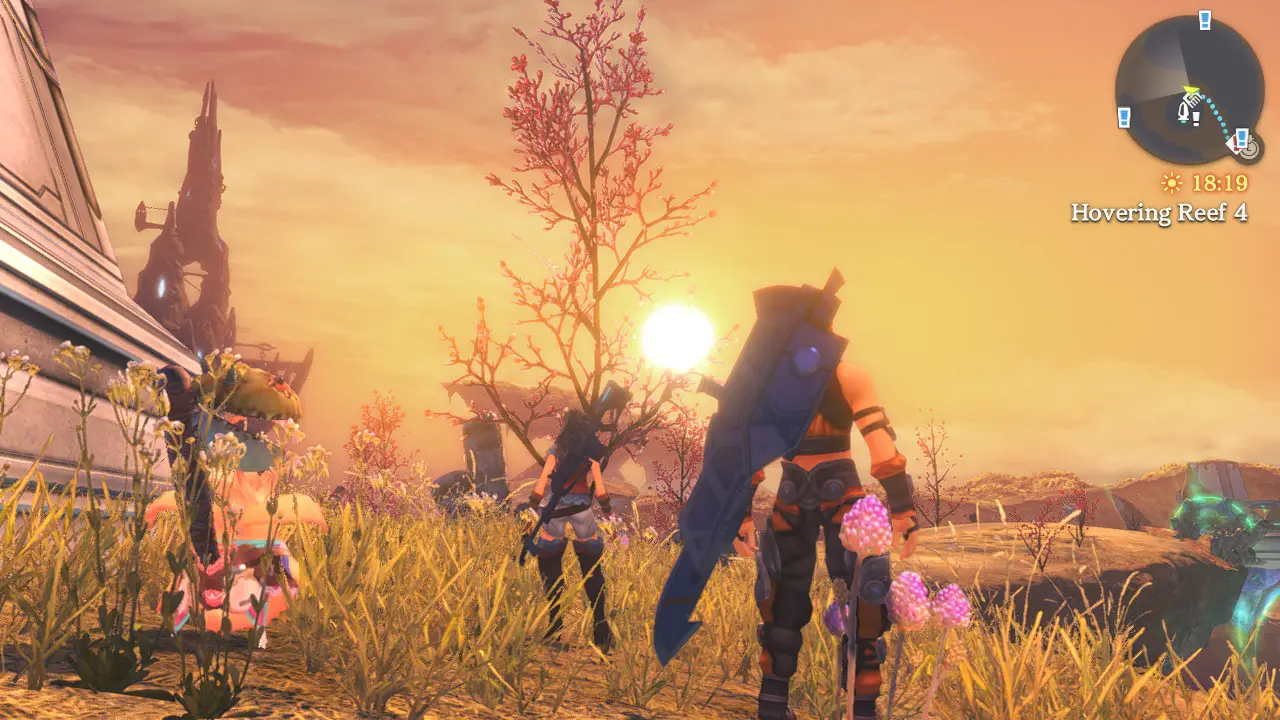
In Xenoblade Chronicles, you’ll explore the massive world of the Bionis, from the rolling hills of Gaur Plain on the knee and thigh to the chilly mountainside of Valak Mountain on the right arm. Each vast area has a completely different atmosphere, like the beautiful borealis in Satorl Marsh at night or the oppressive, metallic fortresses in Sword Valley. There’s a lot to do in each locale as well. There are landmarks to discover, ether veins to mine, unique monsters to defeat, and of course a truckload of side quests that need doing. While you are pulled forward by the story, things you might have missed or problems you’ve yet to solve will make sure you keep coming back. While, yes, we may need to save Otharon before he falls into that river of acid, this poor woman needs art supplies!
Combat in Xenoblade is similar to an MMO, like World of Warcraft or Final Fantasy XIV. You have free reign of movement and eight arts in a pallet at the bottom of the screen, in addition to a central talent art which can be used when it fills up. Arts are essentially different actions your character can take, such as attacking, inflicting a status effect, or healing an ally. Some arts also have bonuses that will increase its power in specific conditions, like being at the enemy’s rear. Once an art is used, it won’t be usable again for a short time, so you’ll need to decide on the fly when is the best time to attack and when it’s better to relent. Aside from defeating your foes, you have two short term goals in battle: build up the party gauge to perform a chain attack and perform a break, topple, daze combo. The party gauge is divided into three segments, and consuming one will allow you to revive a fallen ally while consuming all three will stop time and let each party member use an art in turn, with successive arts of the same color boosting the strength of the next. A break, topple, daze combo, referred to in Xenoblade 2 as a driver combo so we’ll use that terminology here, is a series of status effects inflicted on an enemy to render them defenseless and unable to attack for a short time. First, you inflict break with pink arts to throw off their balance, then a green art to knock them down, and finally a yellow art to keep them down even longer. Some enemies can only be hurt when under the effect of topple or daze, while others may have a hidden ability to counter attacks in this state.
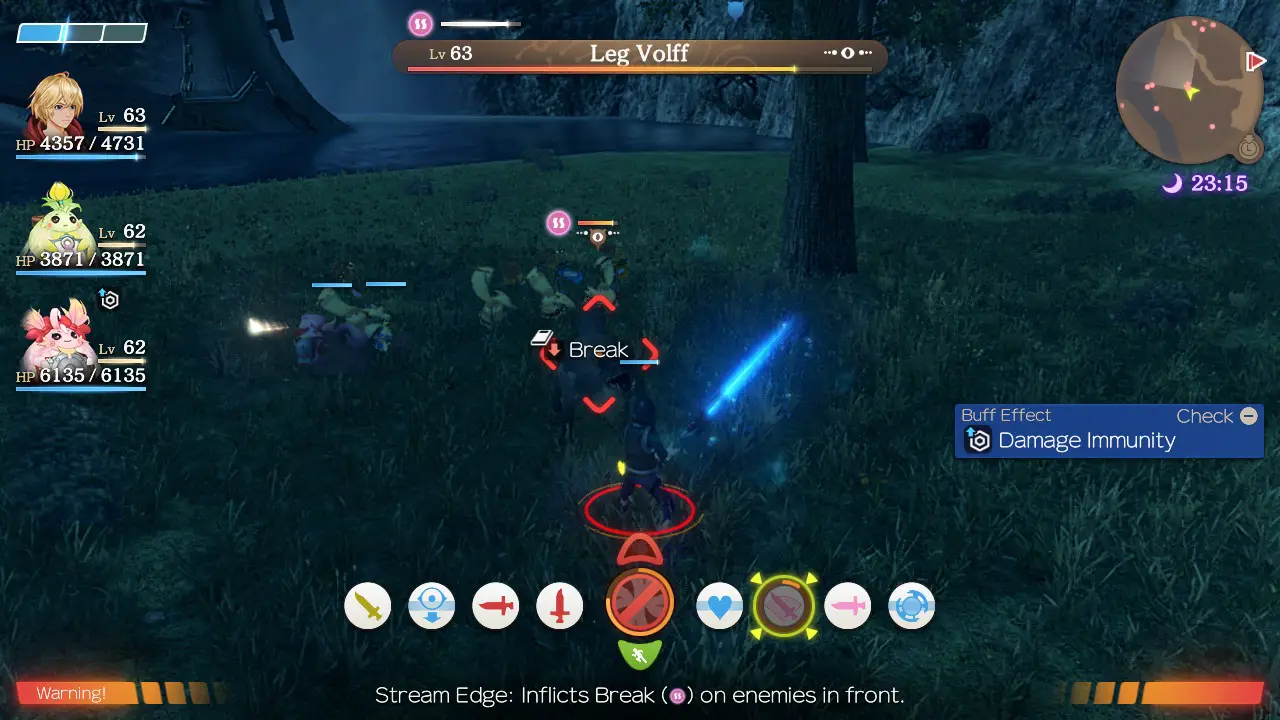
During battle, each character is affected by tension, a representation of how they currently feel. If someone gets discouraged, they’ll begin to miss most of their attacks and do less damage. If they’re hyped up, they’ll become much more focused and do more damage. You can encourage allies by cheering them on when they’re discouraged or helping them up after being toppled and with timed button presses called affinity bursts. When someone misses an attack or lands a critical hit, a circle will appear and pressing the B button at the right time will cheer them on increasing tension and affinity between the party. Outside of battle, you can view the affinity chart which will show you how much each character likes each other. Much like in real life, people who like each other will work better together and, unlike real life, unlock special conversations called heart to hearts in the world. Choosing dialogue options in these scenes will further raise or lower their affinity, which in turn will help them do better in combat and unlock more heart to hearts and so on. As you meet people around the world, you’ll also be able to see their affinity towards both the party and other NPCs in the affinity chart. The affinity system does wonders for connecting combat, story, and exploration while also making the world feel more alive.
As affinity grows between characters, you’ll be able to transfer skills found in their respective skill trees to each other. For example, one of Dunban’s trees focuses on gaining more aggro and agility, the most broken stat, while he’s not wearing clothes. Riki is the character with the most HP, but he’s not very good at holding the enemy’s attention so as he and Dunban grow closer you could give Riki those aforementioned abilities and he’ll be able to do the same thing. This, along with the gem system to fine tune stats and gain bonuses, lets you customize every party member exactly how you want. Want Sharla the rifle toting healer to become more of a damage dealer? Or maybe you want the seventh party member, who shall remain nameless for spoiler reasons, to become an ether attack specialist? Or even make Shulk, frail as he is, a beefy tank? I could go on, but you get the point. Equip the right skills, gems, and armor and you can make anyone anything you want them to be. There’s so much freedom given to you that there’s no one right way to play. Sure, min/maxers may say there’s a best way to build each character, but I say play how you want and you’ll eventually find a way to overcome all of the game’s challenges.
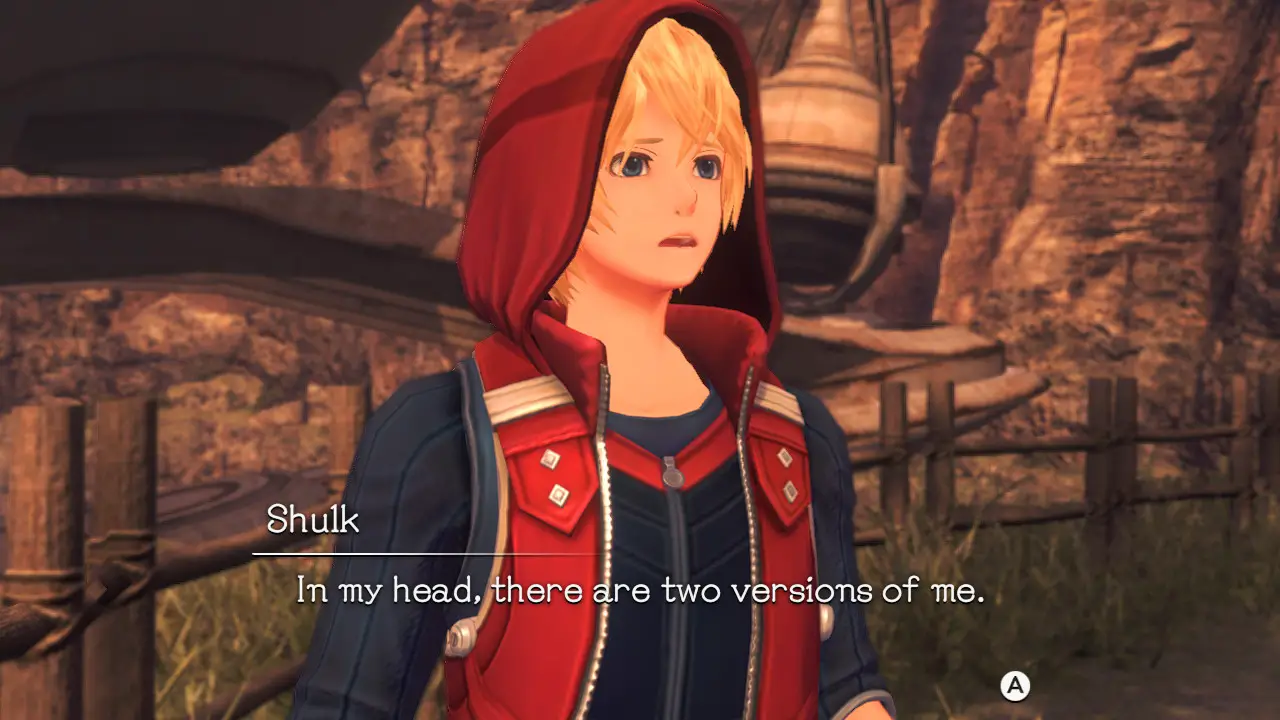
By today’s standards, the original Wii version… doesn’t look good. Sure, its vistas and use of color have their moments, but it’s mostly impressive for fitting a world that large on what’s essentially two Gamecubes taped together. While some have criticized the move towards a more anime art style with Definitive Edition, it gives the characters much more personality with their expressions. It’s now much easier to see the rage on Shulk’s face when he confronts the metal faced Mechon, or how Sharla truly cares for her brother Juju even though she’s scolding him for being an idiot. While it may not be as much of a graphical update as I was expecting, the game looks excellent from every angle, even in portable mode when things get a bit lower resolution and more jaggy. If you’ve only played the game once through, it’s definitely worth visiting Bionis again for the new visuals alone, and maybe noticing some subtle foreshadowing or character moments you may not have picked up on before.
Definitive Edition includes a few quality of life changes that help to make gameplay a bit more enjoyable. Most obvious, track a quest in your quest log and you’ll be able to pull up what you’re supposed to do with the ZR button and the map will automatically show you the shortest route to your objective, though this doesn’t work with finding materials to restore Colony 6 frustratingly. The menus and UI have seen a complete overhaul as well; everything looks great and is easier to navigate and understand. It has a more modern, flat design while still retaining some of the unique look of the original. If you like to dress your best there’s also the addition of fashion gear. Any equipment you’ve had in your inventory will be permanently added to the fashion section so you can make each character look their best, which is great because the primary rewards for the new time attack challenges are new pieces of gear for this express purpose. On top of all those changes and more, like new idle animations, most of the already amazing music has been completely rerecorded, which lends each piece a more full sound and some instrumental flourish like the brass instruments added to You Will Know Our Names. If you still prefer the original though, you can switch back at any time in the options menu.
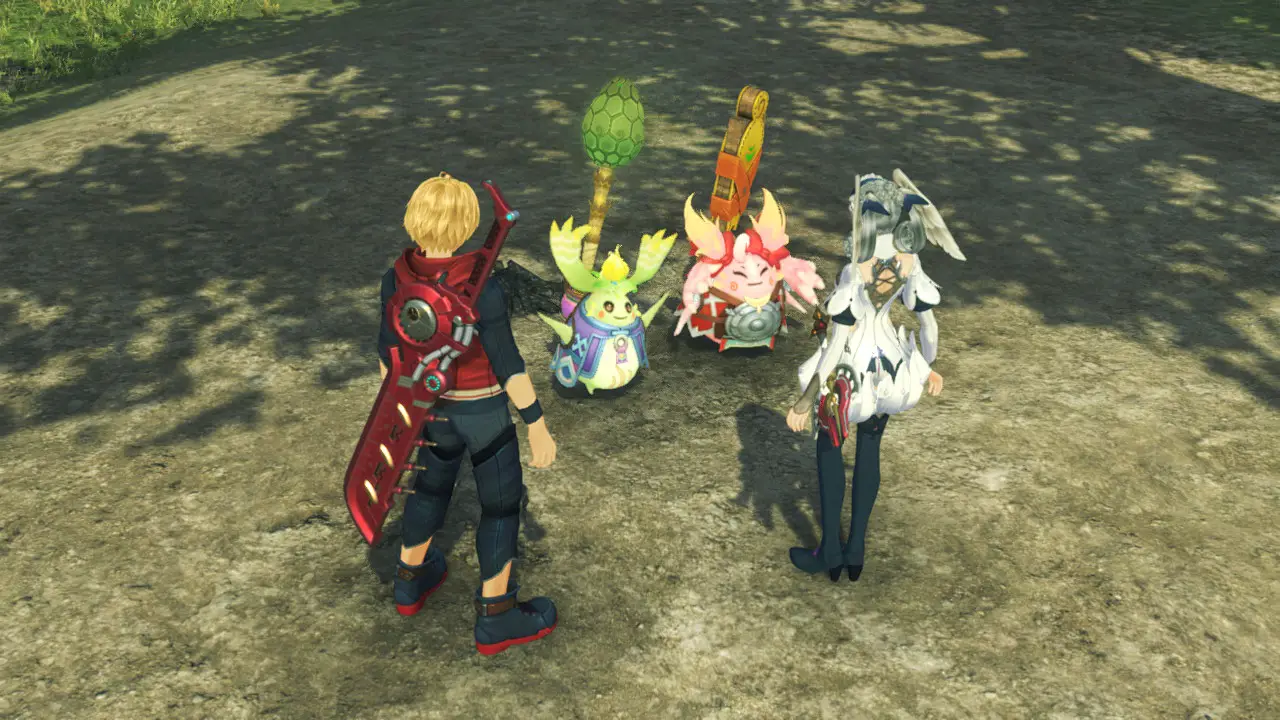
The biggest addition to this version is the new epilogue chapter named Future Connected. One year after the events of the main game, it follows Shulk and fan favorite Mellia along with two of Riki’s children, Nene and Kino, as they journey to the Bionis Shoulder. It’s a much quieter, more low stakes adventure that serves to complete Mellia’s character arc and to just spend more time with these characters we love. While the story may add around 20 hours to your playtime, there’s a ton more to do in these new areas like sidequests and quiet moments, essentially heart to hearts but with voice acting and not dialogue options, to view. While this expansion focuses mainly on Melia, I found Nene to be a highlight of the adventure. She’s still funny and a bit childish like most of the series Nopon characters, but she has much more depth than say Tora from 2 and tries to act like an older sister Kino can rely on and look up to.
Future Connected also makes many changes to the battle system. Shulk and Mellia remain as they were in the main game, with Nene and Kino serving as Reyn and Sharla substitutes, but chain attacks, skill trees, and affinity have been replaced by the Ponspectors. The Ponspectors are a group of Nopon who have traveled to the Bionis Shoulder to survey and explore it, although all twelve of them have been separated so you’ll need to find and help them out throughout your journey. They’ll join you in battle, attacking and buffing the party as they fight. If you have one of each color coded team, you’ll be able to consume all three segments of the party gauge to have them perform one of three special moves:” one to heal the party, one to daze enemies, and one to deal massive damage to a single target in addition to the group damage all options dish out. At first, I thought this was a step back in terms of depth from chain attacks, but as I played I realised that this system was essentially cutting out the middleman and making these moments go much more smoothly and quickly, while also making them less overpowered.
Xenoblade Chronicles Definitive Edition
Phenominal
Xenoblade Chronicles Definitive Edition is the best version of Monolithsoft’s masterpiece. Its additions serve to streamline the experience and make an already great game that much better. Its expansion Future Connected gives some much needed closure on one of the story’s best and most complex characters while spicing up the exploration and combat in a fun, new way. If you’re not already a fan, this version might just hook you like it has so many others.
Pros
- Gorgeous new art style and score
- Tons of quality of life changes
- Future Connected is a fun and worthwhile follow up
Cons
- Can’t track materials for Colony 6 restoration
- Tons of systems may turn off new players
